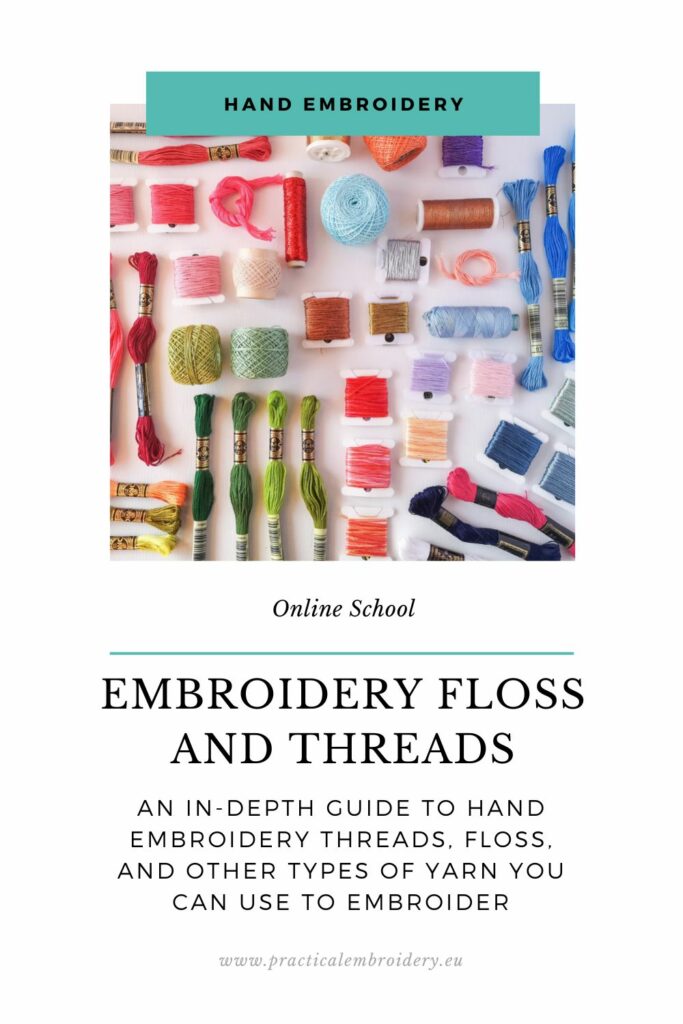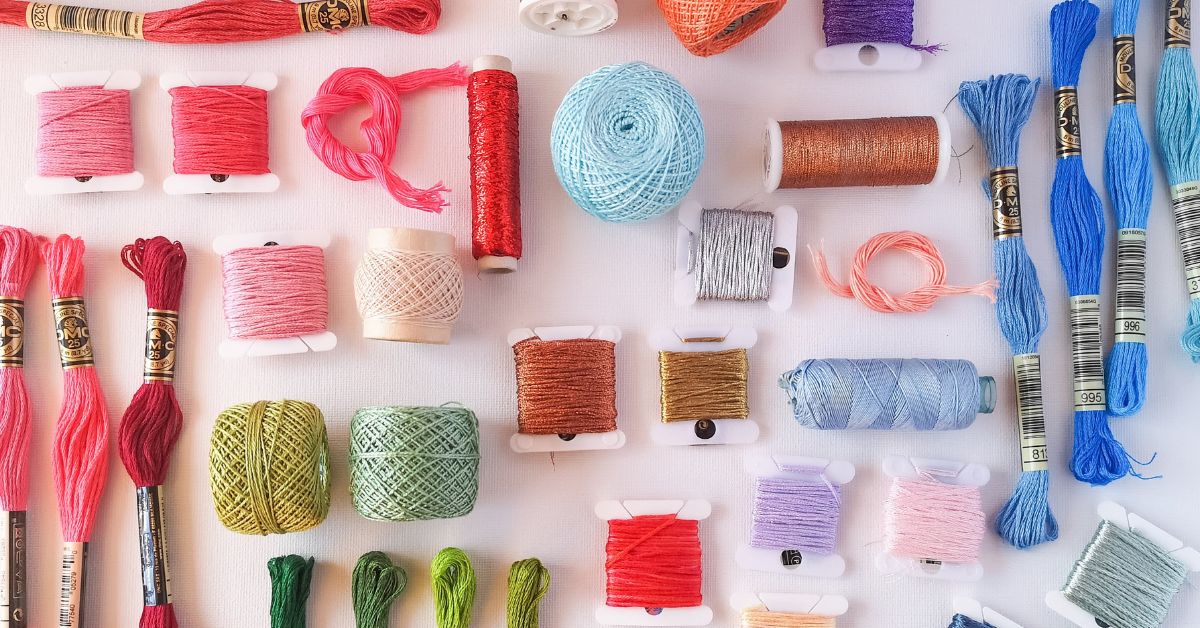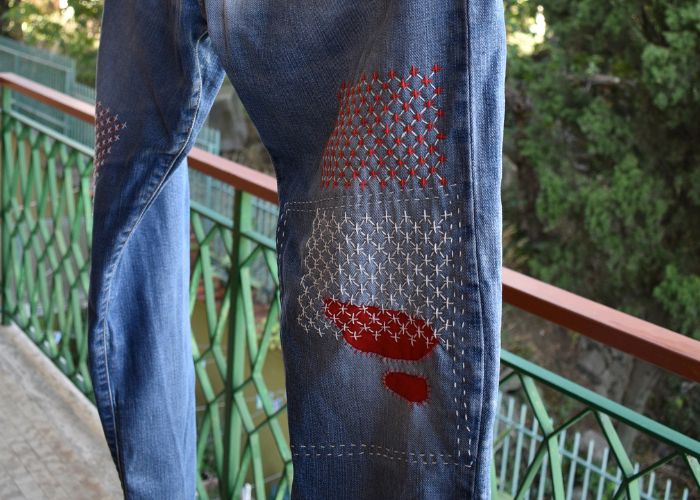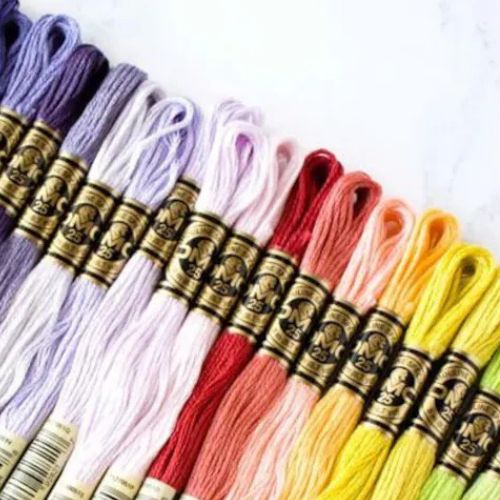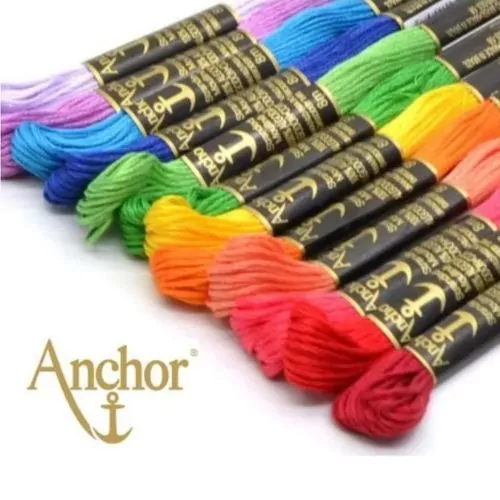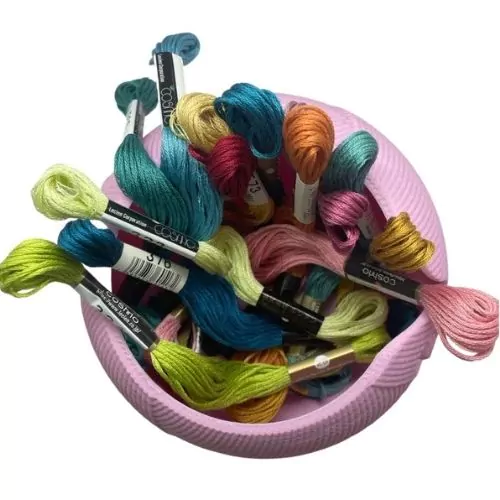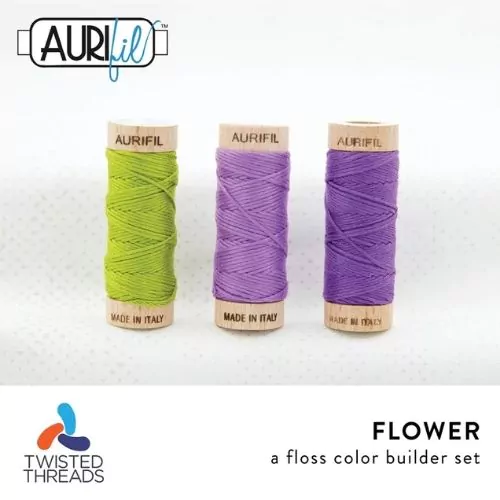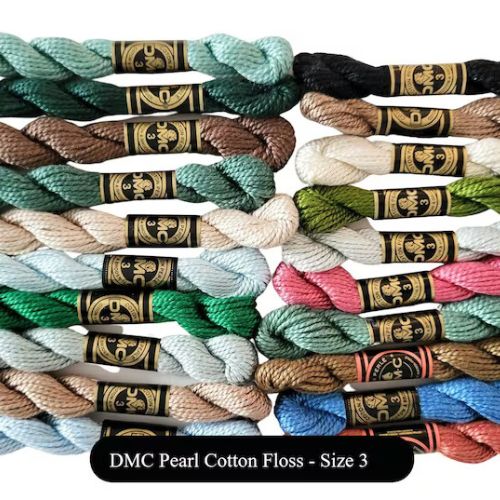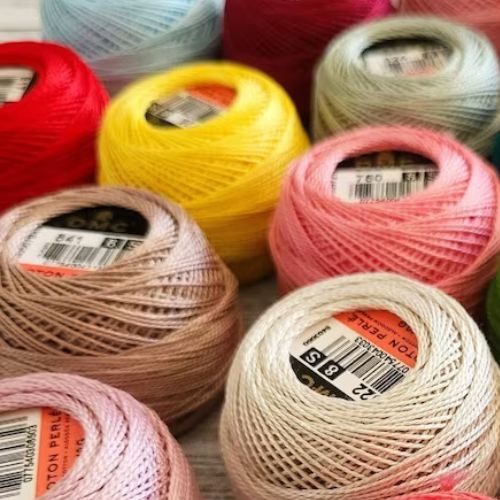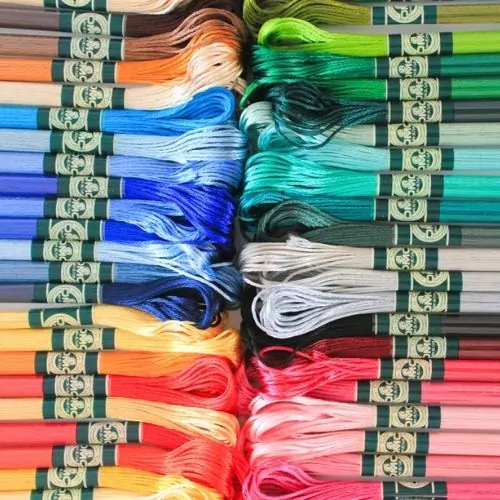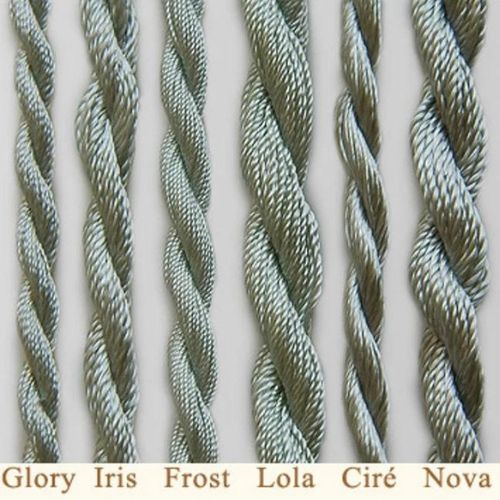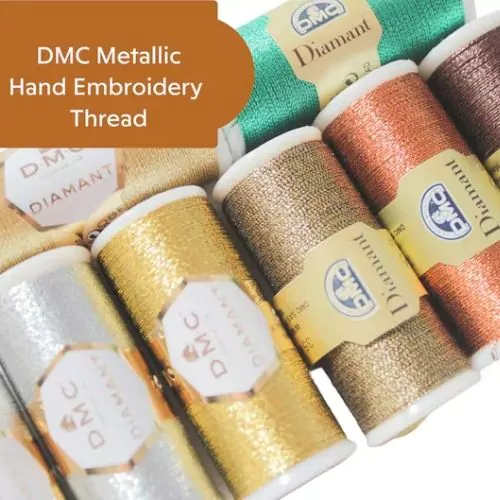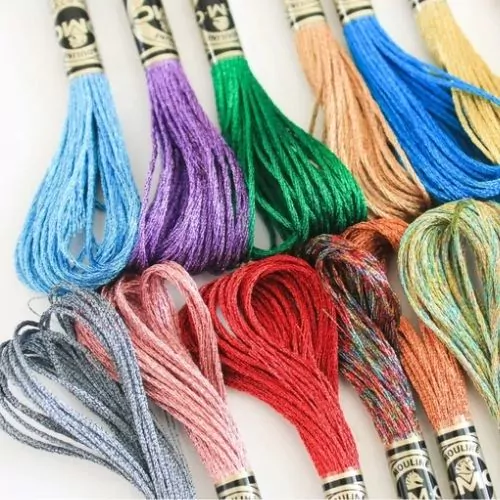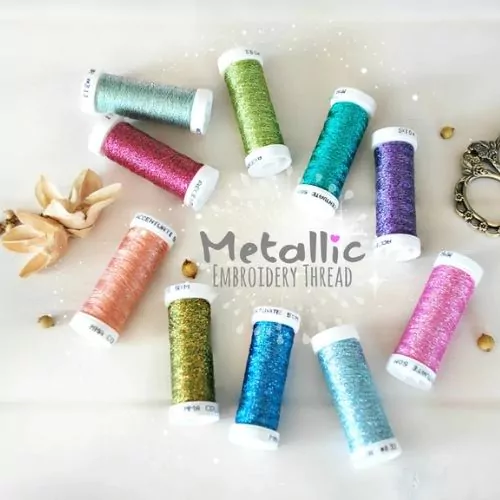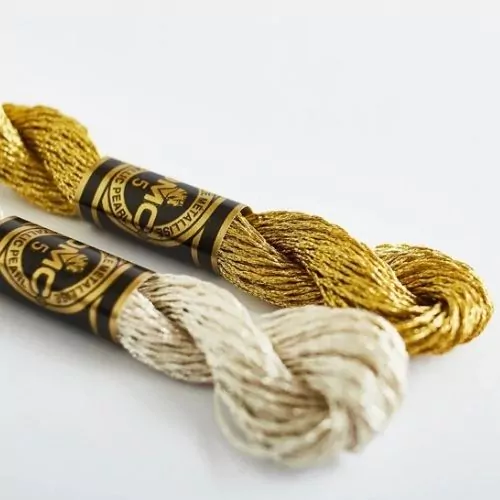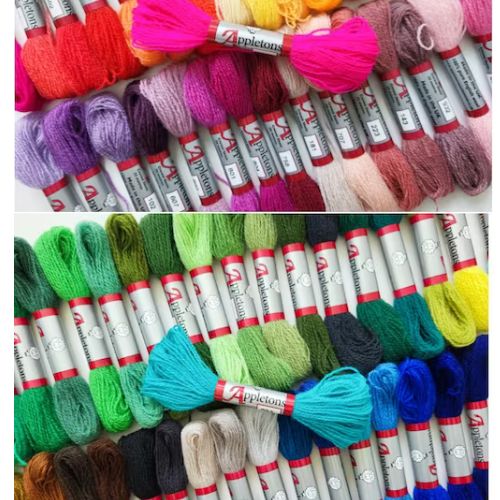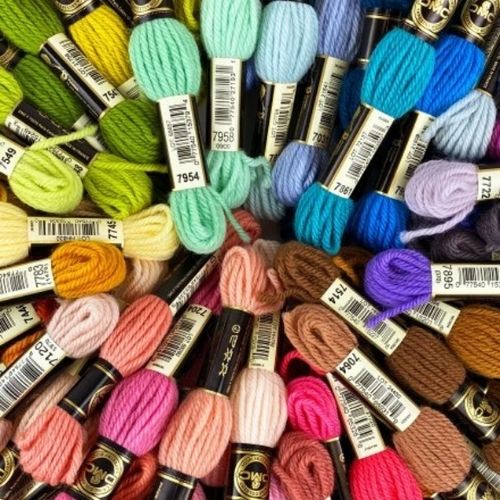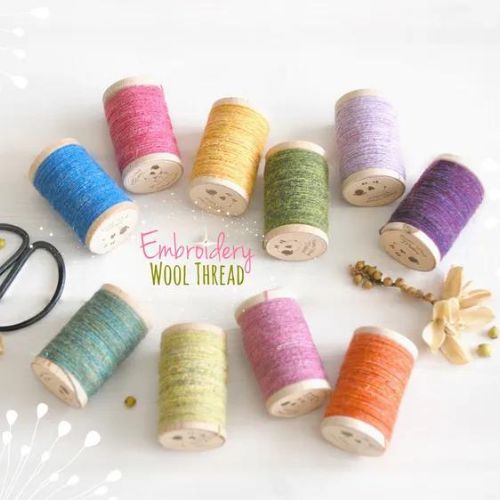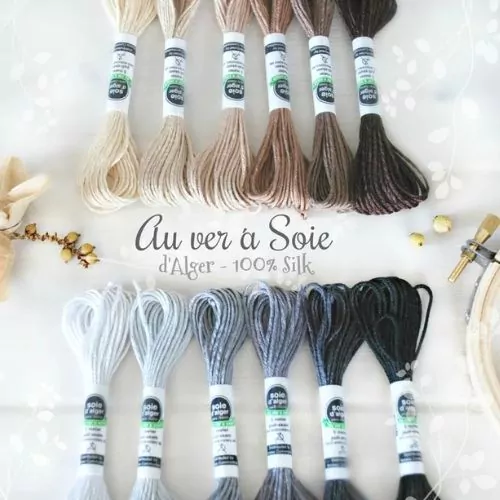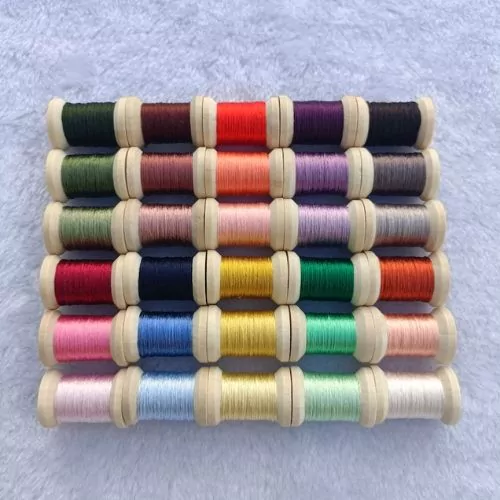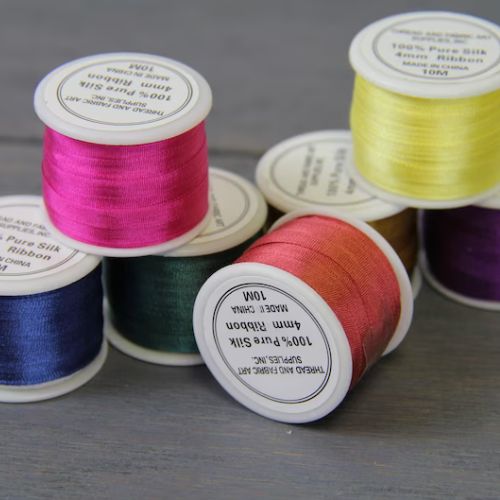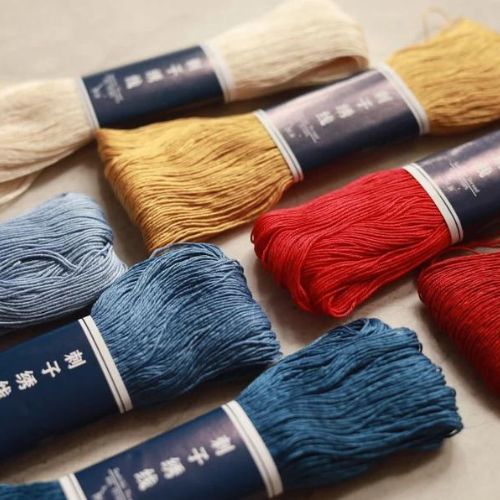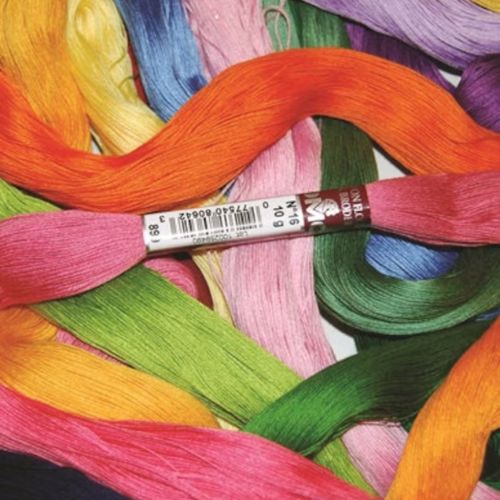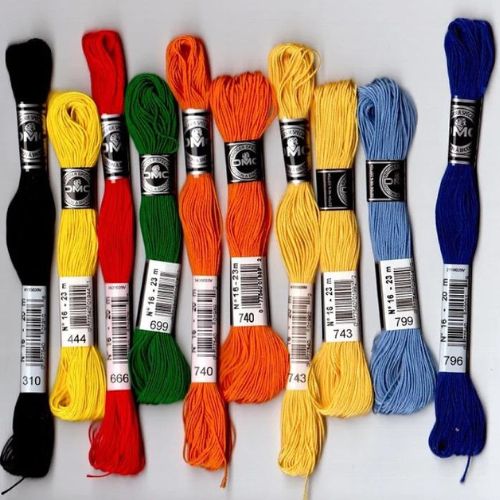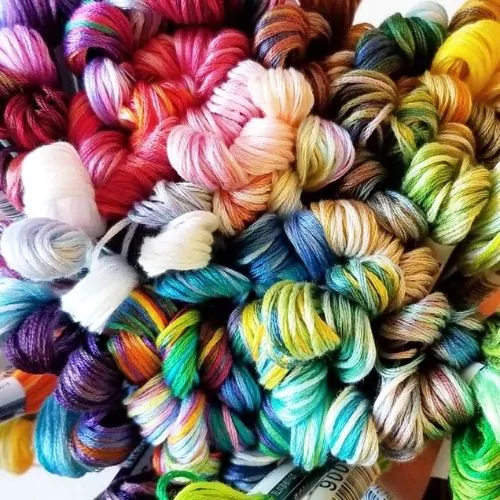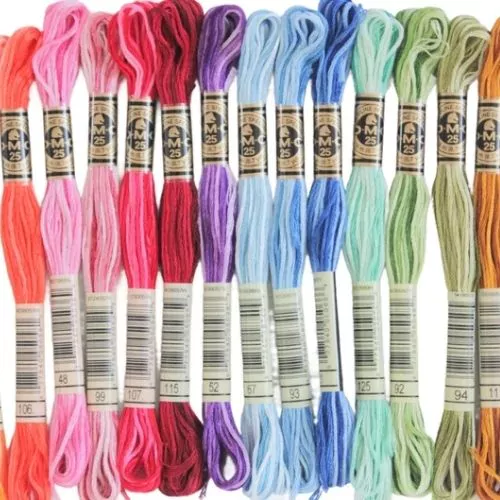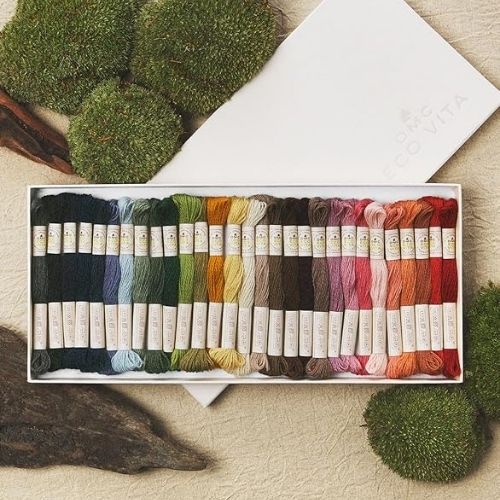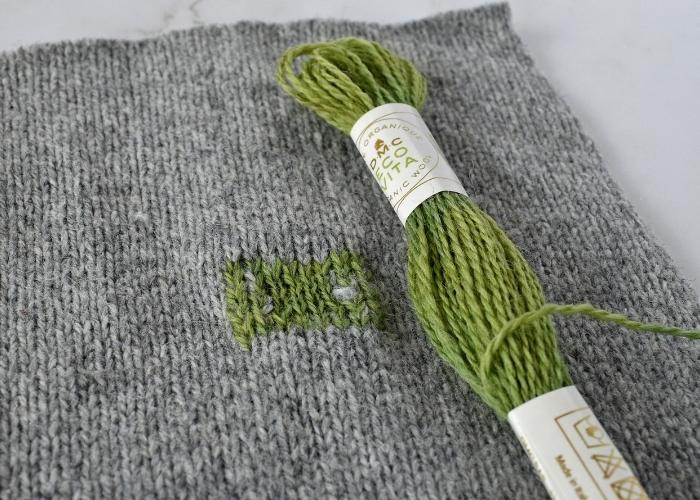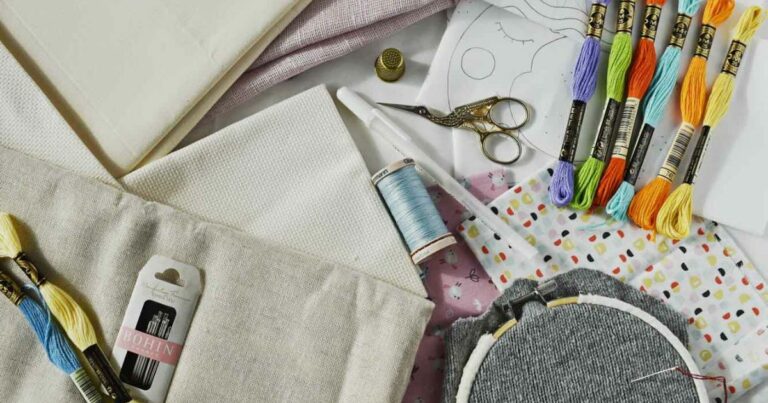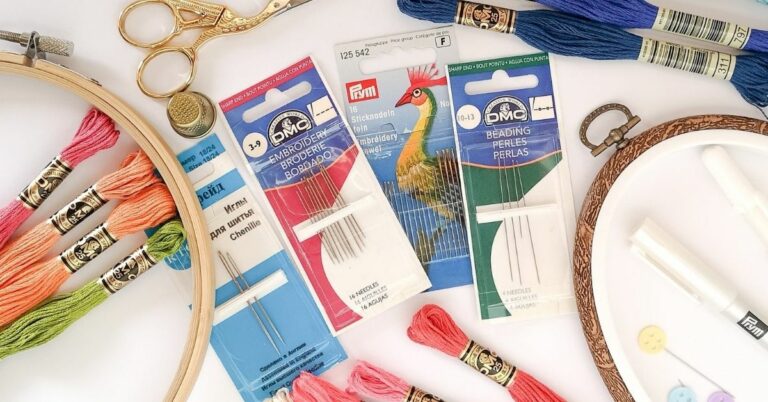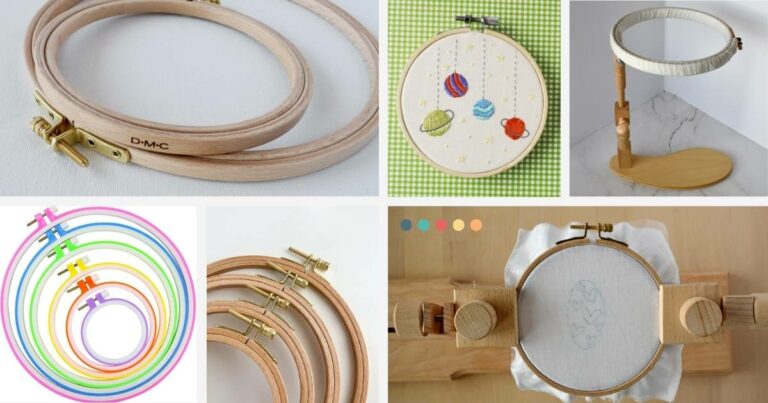Embroidery floss and threads
An in-depth guide to hand embroidery threads, floss, and other types of yarn you can use to embroider
Hand embroidery floss and threads are an essential group of hand embroidery materials. And I get a lot of questions about them. So, first of all, I will answer the most common questions, I get about embroidery floss and threads.
There are 3 most important groups of hand embroidery tools and materials: Fabric, Floss, and the Needle. If you don’t have one of these, you will be unable to do any embroidery.
Q&A
What is the difference between embroidery thread and embroidery floss?
When you read about hand embroidery, you can find that some authors refer to embroidery floss and some – to embroidery thread. So, what’s the difference? Embroidery floss is a mercerized cotton embroidery thread composed of 6 individual threads or plies, which can be separated. You can use any number of strands in the needle. It depends on the desired thickness of the thread or the pattern instructions. So, all 6 threads together are called floss. And separately, they should be called a thread.
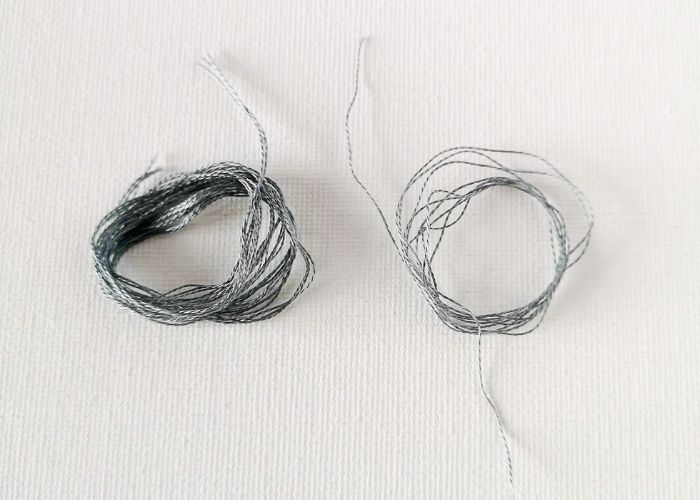
Is embroidery thread the same as sewing thread?
No. The critical difference between embroidery thread and sewing thread is texture. Embroidery thread is a type of thread that has a unique sheen, whereas most sewing threads do not have a sheen. Also, sewing threads are much more resistant.
Can I use regular thread for embroidery?
You can embroider with a sewing thread if you want, but the embroidery may lack the desired effect only embroidery thread can give. So, you better not waste your time and choose the right threads from the beginning. If your artistic idea requires a sewing thread, use it. But don’t try to replace embroidery floss with a sewing thread.
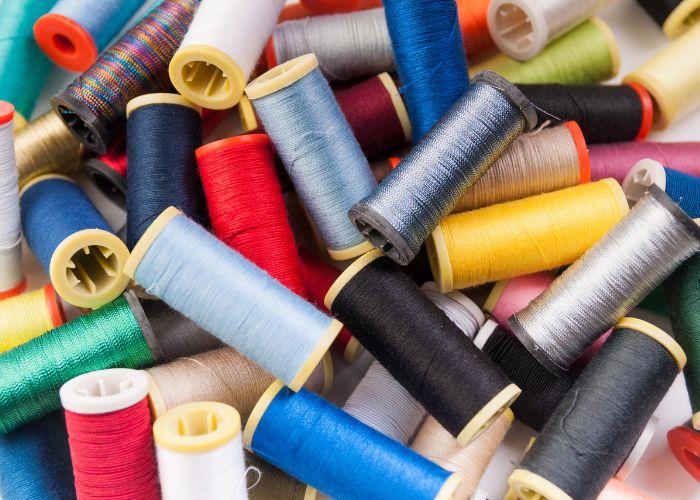
What is the best thread for embroidery?
Many types of threads for hand embroidery. Your choice will depend on your fabric, the embroidery style, and the effect you want to achieve. In the second part of this article, you can read more about different embroidery threads and how to choose the right one for your project.
Is embroidery thread colorfast? Does embroidery floss bleed when washed?
This is a big pain point for embroiders. No thread is guaranteed colorfast by manufacturers. Bleeding colors are reasonably rare, but they do happen.
What can be worse than hours of hard work destroyed after the first wash by the color of the thread bleeding onto the fabric? Maybe I’m lucky or never used the “wrong” colors, but it never happened to me. Still, I’ve heard many stories about red or blue floss bleeding onto white fabric. So, take some precautions if you plan on embroidering on white fabric and wash it later.
First, you can try to wet the piece of thread and the material and watch if the floss is bleeding. If so, you can set the color by prewashing. Fill a bowl with 4-5 liters of cold water, and add 2 tablespoons of white vinegar and 2 tablespoons of salt. Soak your thread, one color at a time, in the mix for 10 minutes. Remove the floss from the water, blot it with an old, clean towel, and allow it to dry naturally. Remember that hot water or a steam iron can re-activate the dyes and cause bleeding.
Types of embroidery floss and threads
Stranded Embroidery Cotton or cotton embroidery floss
Stranded Embroidery Cotton is also known as Cotton Embroidery floss or cotton mouline. It’s a classic go-to for any traditional hand embroidery project, from cross-stitch to silk shading. Also, you can use embroidery floss to do any other forms of needlework like counted thread embroidery, needlepoint, smocking, crewel, punch embroidery, appliqué, and quilting. Besides that, we can use embroidery floss to:
- make friendship bracelets
- create dream catchers
- weaving
- make tassels
- create jewelry with beads
- wrap your hair braids
- anywhere where colorful threads are needed.
Because of its durability and a wide choice of colors, cotton embroidery floss has wide use in all types of crafts.
Embroidery floss works best on cotton, linen, and all types of cotton-linen mixed materials. There is a wide choice of colors, and you can use 1 to 6 threads which allows you to vary your stitching results depending on the number of strands used.
The best-known producers of embroidery floss are DMC (454 solid colors and 18 variegated colors available) and Anchor (460 solid shades and 24 multicolor shades). Still, some smaller brands like Retors du Nord by Sajou, Cosmo, Aurifil, and others offer high-quality floss.
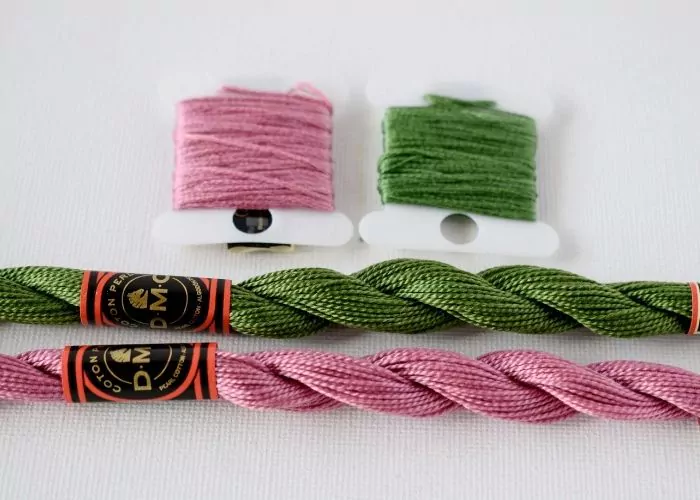
Pearl cotton
This type of cotton thread is also called Perle cotton. Pearl cotton is a 2-ply twisted thread with a high sheen. Unlike stranded cotton, it is non-divisible (the strands cannot be separated). Pearl Cotton comes in different thicknesses: 3, 5, 8, 12, and 16, with 3 being the heaviest and 16 the finest. Size 8 is equivalent to 3 strands of embroidery floss. We use Pearl cotton for cross-stitch, surface embroidery, and crochet. It is best to use it on natural fabrics like cotton or linen.
Best known producers of Pearl cotton are DMC and Anchor. They offer a wide range of colors and sizes.
Rayon Floss
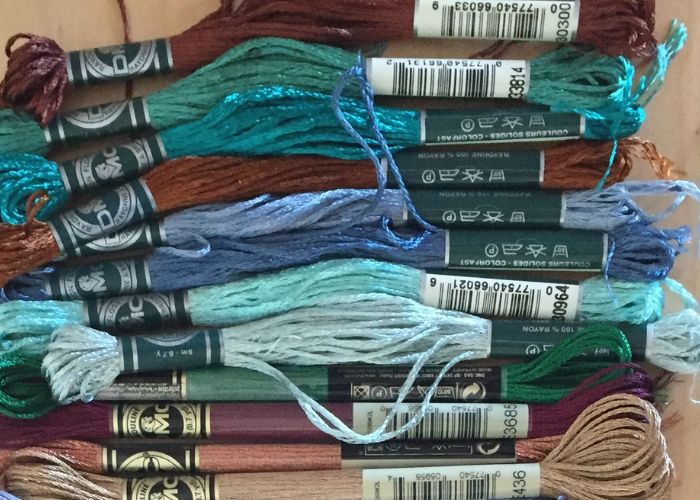
It is a man-made, synthetic fiber that gives the appearance of silk while being more economical. Rayon fibers are best known for their use in Brazilian embroidery but we can also use them in other techniques. For example, you would probably want to use them for a specific area rather than stitching the whole piece in rayon. In addition, it can add some charming shiny effects to your artwork or clothes.
Best known producers of rayon are DMC (DMC Satin Rayon Floss), Anchor (Anchor Marlitt), and EdMar (Cire, Lola).
Metallic thread
There are various types of metallic embroidery thread:
- Regular Stranded Metallic Floss (like DMC’s Light Effects or Anchor Metallic).
- Woven Metallic Floss (like Kreinik Fine Braid or Au Ver a Soie braid).
- Metallic Blending Filament typically worked alongside other embroidery threads (like Anchor Lamé).
Also, recently DMC released a new metallic thread called DMC Diamant. I’m not sure which group it belongs to. When stitched up, Diamant is equal in thickness to about two strands of DMC floss, and unlike most metallic threads, it’s much easier to work with.
We can use metallic threads for the lettering or to add some details to colored embroideries. However, keep in mind that all metallic threads require some experience and a lot of patience as they tend to break and tangle while embroidering.
If you would like to learn how to embroider with metallic threads – read the article “Hand Embroidery With Metallic Thread: Tips & Tricks for Smooth Stitching” to start your learning journey.
Crewel yarn
Crewel yarn is a 2-ply (2 strands twisted to make 1 thread) wool thread. Unlike standard cotton embroidery floss, you don’t separate this thread, and it’s much thinner than tapestry wool. As the name suggests, we use this thread for crewel embroidery (on linen and linen twill). Still, you can use this thread to embroider wool clothes and knitwear. Also, with double folded crewel yarn you can make cross-stitch on 10 count canvas base.
Best-known Crewel threads are Fine d’Aubusson by Au Ver a Soie, Appleton wools, Bella Lusso, and Simply Wool by Gentle Art.
Tapestry Wool
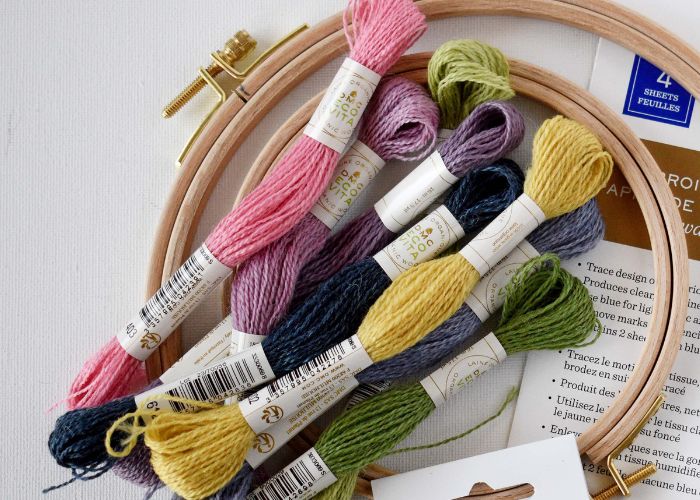
Tapestry Wool is much thicker than crewel, almost like knitting wool. It is 4-ply (4 strands twisted to make 1 thread). We use single strand to stitch on a canvas base when doing canvas work or tapestry. To embroider on thicker wool knitwear and other looser woven materials – use all strands.
The Best-known tapestry wool producers are DMC (Tapestry wool), Anchor (Tapisserie Wool), and Appleton Wools.
Silk Threads
There are two main types of silk threads:
- spun silk
- filament silk
Spun silk is made from broken silk cocoons and leftovers and spun into a thread, similar to how cotton or wool is spun. Like cotton, a skein of spun silk consists of a thicker yarn that can be separated into strands. You can stitch with spun silk like you stitch with cotton floss. It looks good in silk shading, as the colors blend in smoothly.
Best known producers of spun silk are Au Ver a Soie ( Soie d’Alger), used by high fashion brands and by many hand dyers, Madeira and Kreinik (Silk Mori).
Filament silk is not “spun” from fibers like spun silk but reeled straight off the cocoon. Filament silks can be flat or twisted.
Best known producers of filament silk are Au Ver a Soie, The Silk Mill, Trebizond, and Mulberry Silks.
The problems encountered when using silk threads in embroidery work are that they fade quickly and may bleed. However, despite these minor flaws, silk is a beautiful and pleasant thread.
Ribbons
There are many different types of ribbons that we can use for hand embroidery. These ribbons can be silk, cotton, or synthetic and are available in varying widths, from a narrow 1/8 inch to 1/2 inch or larger.
Ribbon embroidery can be used on its own or in combination with other surface embroidery styles to add some details.
Sashiko thread
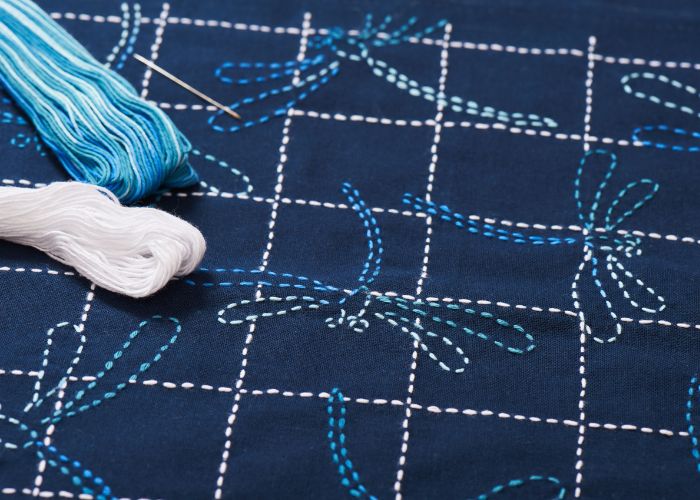
Sashiko thread is a tightly twisted heavy-weight cotton thread used in traditional Japanese sashiko – a form of Japanese folk embroidery using the basic running stitch to create a patterned background. Traditional sashiko uses indigo-dyed fabric and white sashiko thread. Still, you can find sashiko thread in many colors and even variegated ones. Sashiko thread has no strands like embroidery thread. It is made of fine threads twisted together to make a single thread (yarn). You use the entire strand when stitching with it. This thread has a rougher texture and a flat rather than a shiny finish. To achieve an authentic sashiko look, you should definitely search for sashiko threads and use them.
The best-known sashiko thread producers are Olympus (Kogin and Coron Sashiko Threads), Cosmo Lecien (Hidamari Sashiko thread), Yokota, and Maito.
Floche
It is a twisted thread made from the finest long-fiber cotton, mercerized to create a beautiful finish. Floche comprises five plies twisted together to make one non-divisible thread. It is a 5-ply lightly twisted thread that gives better coverage than 2-ply stranded floss. This superior-quality thread is especially great for delicate embroidery.
The best-known producer of Floche is DMC (DMC Floche comes in 94 colors).
Coton a broder
Coton a broder is a 100% cotton non-divisible thread, durable and colorfast, especially suitable for delicate embroidery on table linen, furnishings, monogramming, whitework, and cutwork.
In white, Coton a broder is available in various sizes, from size 16 (the largest) through size 35. Unfortunately, only one measure of Coton a broder – size 25 – comes in colors.
Best known producer of Coton broder is DMC (DMC Coton broder comes in 182 colors).
Variegated embroidery threads
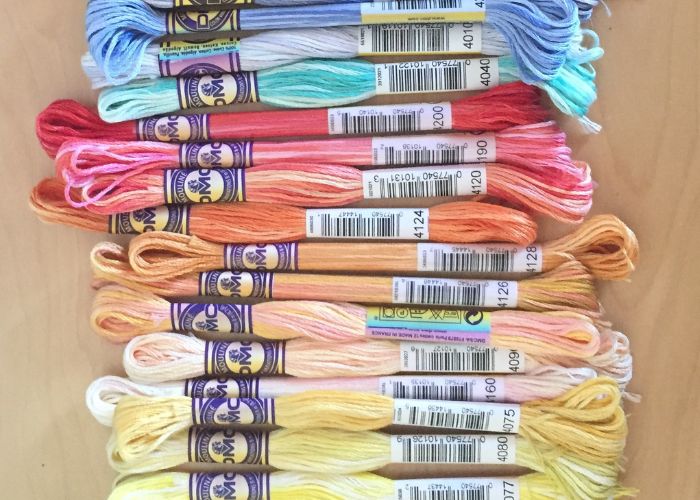
Embroidery threads that change color within the same thread are called variegated embroidery threads. You will find variegated cotton floss, pearl cotton, and even wool. Variegation can result from an over-dyeing thread, space-dyeing thread, and other methods. There are two main variegated color blends, tone on tone and contrast. Tone-on-tone colors consist of multiple shades of a single color, such as dark green and medium green, that provide a gradient effect when stitched. Contrast colors consist of various dyed colors in a repeating pattern and stand out against the fabric. Variegated floss is a great way to add dimension to your project. Most embroidery thread producers have variegated thread lines.
Embroidery threads and floss i recommend
Other threads
Besides all the specific floss, threads, and yarns described above, there are even more special threads that you might need. It can be nylon beading threads for attaching glass beads, waxed threads for leather, or special goldwork threads for goldwork embroidery.
How to choose the best embroidery floss or thread for your embroidery project
There are 3 main criteria when choosing the right thread for the embroidery:
- Type of the embroidery you are going to make. Crewel wool for crewel work, sashiko thread for sashiko, etc.
- The fabric on which you are going to embroider. Don’t waste silk threads on cheap synthetic materials. Use embroidery floss for all kinds of cotton and linen and the wool threads for wool fabrics and knitwear, and you’ll be covered.
- The quality of the thread. Embroidery projects take hours to be made, so don’t save pennies by buying low-quality threads, as they may ruin your work.
Final thoughts
Various embroidery floss, threads, and yarns are created for hand embroidery purposes. Choose the high-quality thread suitable for your project if you want your hand embroidery art to stand out.
But also, remember that all said above is a theory and suggestions. In hand embroidery, you can use any type of thread that you can thread into the needle and pass through the fabric. Couch knitting yarns with sewing threads and ribbons with silk threads. Use the mix of all possible thread combinations and techniques in one project to create an original fiber art piece.
More about embroidery tools and materials on this Blog
